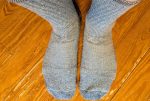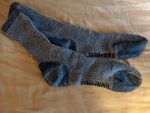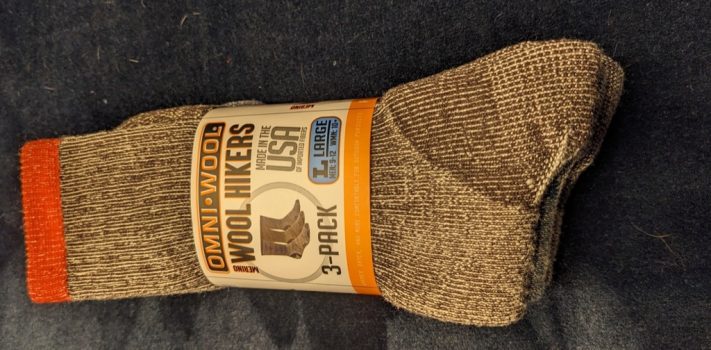OmniWool Merino Wool Hiking Socks are comfortable and reasonably priced socks that are appropriate for everyday or field wear. Early in my testing, I would not have recommended them for extended field use. At first, the socks began to get less comfortable after a couple of days of continuous wear. But over the intervening months of use, they have gradually become more and more comfortable. Now I would not hesitate to wear them for extended field use, as well.
At the time of this writing, the socks in size medium were priced at $19.99 for a 3-pack at www.crescentsockshop.com. In size Large, the socks were out of stock.
Background
A couple of years ago, I decided that I was done buying cotton socks. Cotton socks tend to wear out too quickly, do not wick moisture well, and provide no effective insulation when wet.
Instead I have been gradually acquiring a supply of wool socks to replace my cotton socks as the cotton socks wear out. I have been keeping my eye out for good deals on decent wool socks, and buying them a pair or so at a time as the opportunity has presented itself.
My focus has been on finding good wool socks, since there are not many things more uncomfortable than bad wool socks. Generally, I have been looking for material containing a high-quality wool like merino, with the blend consisting at least 50% wool and no cotton.
About four months ago, I was at a nearby warehouse club retail store. Three-packs of OminWool Merino Wool Hiking Socks were on clearance there for $8.81 a pack. That came to just $2.94 a pair. I decided to give them a try.
Unfortunately, I did not pay close enough attention to what size socks I was placing in the shopping cart. I bought medium. I wear large. I did not notice my mistake until I got home.
Fortunately, my wife “Kari” wears medium, and she also wanted some additional wool socks. It also worked out that Kari was in the vicinity of the warehouse club store the next day. She picked up a pack of socks for me in size large. It is wonderful to be blessed with a thoughtful, considerate, and helpful wife.
Description
OmniWool Merino Wool Hikers are “Made in the USA of imported fibers.” I went online to read the Federal Trade Commission’s 42-page guide “Complying with the Made in USA Standard.” I was wondering why socks made with imported fibers often can be classed as “Made in the USA” but knives made of imported steel generally cannot. The answer has to do with how significant a percentage of the final value is represented in the raw material, and how significant the issue of imported materials will likely be to consumers. I can understand the reasoning behind these rules, but they seem somewhat subjective. The major problem with subjective rules is that their enforcement can become arbitrary and capricious. Politically favored groups can receive a pass while politically disfavored groups are held to the strictest possible interpretation of the rules.
The large socks are supposed to fit men with shoes sized 9-12 and women with shoes sized 10+. The medium socks are for men with shoes sized 6-9 and women with shoes sized 7-10.
 The 3-pack socks come in 3 different colors: brown with red trim, blue with navy trim, and gray with light gray trim. The label on the socks indicates that OmniWool is a “Certified WBENC Women’s Business Enterprise.” I must admit that I find that label to be inappropriate in the same way that I would find a “Certified MBENC Men’s Business Enterprise” label to be inappropriate. I think it is boorish to favor a particular business enterprise over others based solely on the biological sex of its owner regardless of whether that owner is a woman or a man.
The 3-pack socks come in 3 different colors: brown with red trim, blue with navy trim, and gray with light gray trim. The label on the socks indicates that OmniWool is a “Certified WBENC Women’s Business Enterprise.” I must admit that I find that label to be inappropriate in the same way that I would find a “Certified MBENC Men’s Business Enterprise” label to be inappropriate. I think it is boorish to favor a particular business enterprise over others based solely on the biological sex of its owner regardless of whether that owner is a woman or a man.
 I looked up the RN number on the label and discovered that OmniWool is a brand of the Crescent Sock Company. The www.omniwool.com address on the label was not functional at the time of this writing, but the www.crescentsockco.com address of the Crescent Sock Company was. Crescent Sock Company owns a number of other brands as well. I found the socks offered in the Hiwassee Trading Company brand to be the most interesting ( www.hiwasseetrading.com ).
I looked up the RN number on the label and discovered that OmniWool is a brand of the Crescent Sock Company. The www.omniwool.com address on the label was not functional at the time of this writing, but the www.crescentsockco.com address of the Crescent Sock Company was. Crescent Sock Company owns a number of other brands as well. I found the socks offered in the Hiwassee Trading Company brand to be the most interesting ( www.hiwasseetrading.com ).
The OmniWool socks being reviewed consist of 56% merino wool, 25% nylon, 18% acrylic and 1% Lycra spandex. I have seen imported socks with as little as 10% merino wool labeled as “merino wool socks.” I am happy to see that these socks consist of more than 50% merino wool. I don’t understand how socks that consist mostly of something else can be labeled as “merino wool socks.”
In Leviticus 19:19 the Mosaic law forbade the use of blended fabrics. Deuteronomy 22:11 repeats this command specifically in relation to linen and wool. It is possible that this is because that blend of textiles was reserved for priestly garments, especially the high priest’s ephod (Exodus 28:6). It is possible that this was intended as a picture of the need for the nation of Israel to maintain its distinctness from the surrounding nations. Perhaps, like the prohibition against the eating of pork, there were practical health benefits related to the command as well. The prohibition has not generally been understood by the Jewish community as applying to wool/synthetic blends.
The label on the socks recommended turning them inside out before washing. I have not done this, nor have I told Kari about this recommendation. If I turned the socks inside out before putting them in the laundry hamper, Kari would think I had been careless when I took them off. If I told her about the recommendation, she might feel obligated to go through extra steps when laundering socks. Kari has enough to do without spending her time turning socks inside out before washing and right side out afterward.
Testing
The proof of the pudding is in the eating, and the proof of the socks is in the wearing. I put the socks in my sock drawer, and put on the first pair the following day.
The socks initially provided excellent comfort and fit. I went about my day with a little extra spring in my step because the socks were so comfortable.
As mid-weight socks, they are a little thicker than most of my everyday-wear socks. This made my shoes feel a little tighter a little earlier in the day.
 I was planning to wear the socks for a number of days to get a sense of how they might work under field conditions when extended wear sometimes becomes necessary. But by the end of the second day, the socks began to feel significantly less comfortable. It felt like perhaps the pile lining on the inside of the socks was beginning to become matted and to retain moisture. So I changed into a clean pair, and had happy feet for a couple of more days. Then I changed into the third pair, and had happy feet for yet another couple of days. So the socks initially felt pretty good for a couple of days, and then not so much.
I was planning to wear the socks for a number of days to get a sense of how they might work under field conditions when extended wear sometimes becomes necessary. But by the end of the second day, the socks began to feel significantly less comfortable. It felt like perhaps the pile lining on the inside of the socks was beginning to become matted and to retain moisture. So I changed into a clean pair, and had happy feet for a couple of more days. Then I changed into the third pair, and had happy feet for yet another couple of days. So the socks initially felt pretty good for a couple of days, and then not so much.
I thought maybe I was becoming increasingly squeamish about dirty socks in my old age, so I repeated the experiment with a pair of Darn Tough Wool Socks. The Darn Tough socks felt more comfortable after 3 days of wear than the OmniWool socks did after only 2 days.
But as the OmniWool socks were repeatedly laundered over the course of the following months, they gradually became more and more comfortable during extended wear. This is a common pattern. Wool socks often become more comfortable after repeated laundering. As a result, I recommend never wearing brand new wool socks in the field if the need for extended wear is likely.
The socks provided great insulation during the testing period, keeping my feet toasty warm while I was out splitting wood in the snow or attending to various other tasks outside.
In my opinion, cotton socks have just one advantage over wool socks. After bucking wood with a chainsaw, I find it easier to brush sawdust off of cotton socks than off of wool socks. That is the one task for which I will intentionally choose cotton socks over wool socks if I have the choice.
It seems that lightweight wool socks remain comfortable longer during extended wear than medium or heavy-weight wool socks. I believe that lighter-weight socks may wick moisture away from the foot more efficiently than heavier-weight socks.
Conclusions
 High-quality wool socks like Darn Tough brand socks seem to remain more comfortable than cheaper brands during long periods of extended wear. As a result, I recommend those higher-quality socks for field use. However, these OmniWool Merino Wool Hiking Socks are almost as comfortable as Darn Tough socks during extended wear, and they are quite a bit less expensive. If you can’t afford the more expensive brands, then OmniWool socks are a whole lot better than cotton or most other alternatives. They have earned a place in the regular rotation in my sock drawer.
High-quality wool socks like Darn Tough brand socks seem to remain more comfortable than cheaper brands during long periods of extended wear. As a result, I recommend those higher-quality socks for field use. However, these OmniWool Merino Wool Hiking Socks are almost as comfortable as Darn Tough socks during extended wear, and they are quite a bit less expensive. If you can’t afford the more expensive brands, then OmniWool socks are a whole lot better than cotton or most other alternatives. They have earned a place in the regular rotation in my sock drawer.
So if you can find OmniWool Merino Wool Socks at a good price, I recommend that you buy some. They are not quite the best, but they are very good.
Disclaimer
I did not receive any financial or other inducement to mention any vendor, product, or service in this article.










